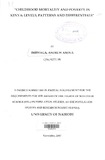| dc.description.abstract | This research project focused on the estimation of the current levels of
childhood mortality (measured by Under-five) in Kenya, generally, and in
light of poverty, using secondary' data from the 2005/06 Kenya Integrated
Household Budgetary Survey (KIHBS2005/06), which was conducted by the
Kenya National Bureau of Statistics (KNBS)in the Ministry of planning and
National Development.
The main objective was specifically, to assess childhood mortality levels,
patterns and differentials with respect to poverty in Kenya. This was done by
investigating how childhood mortality was related to some of the households'
socio-economic and environmental characteristics such as; poverty status
(food, absolute and hardcore), place of residence, region of residence and
educational level. Jndirect estimation method was applied to the data.
Estimation of the probability of dying between birth and certain exact
childhood ages q(x), was done using the Trussell variant form of the Brass
technique. This method focuses on number of children ever born (CEB),
children dead (CD) and number of women aged 15-49;from births histories of
women in the age group 15 - 49 interviewed in the survey. Estimates of
#' •..•
childhood mortality rates were obtained by various factors that were thought
to influence and affect them.
Moreover, household's socio-economic characteristics are known to have
significant impact on child mortality. Outcome measures include childhood
and under-five mortality rates. The socio-economic variables selected for the
study were poverty (absolute poor and non-poor), place of residence; other
proximate variables are toilet facility, source of drinking water, cooking fuel
etc. The framework adopted in this study was based on the one developed by
Mosley & Chen (1984)for studying child survival in developing countries.
The results of the analyses are presented and discussed in chapter 4. The
results from the Trussell estimation indicated that childhood (U-5) mortality
is still high in Kenya; and that poverty increases levels of childhood mortality.
With respect to the first objective, levels of childhood mortality in Kenya are
still high with regional variations maintaining the trends of high, medium
and low mortality zones. U-5 mortality ranged from 46 to 145 per 1,000 live
births (without poverty); and from a low of 30 to a high of 168 when poverty
is included in the estimations. Sex differentials ranged from a low 59 (males)
in Nairobi to a high of 199 (males) in North Eastern province. Further, the
findings show that childhood mortality, as measured by (qs), is much lower
than that of 115 obtained in the 2003KDHS. The findings further suggest that
female U-5 mortality is higher than that of male mortality in two provinces of
Kenya: Coast and Nyanza, which is in contrast with findings often cited in
literature. Thus, the female advantage has been reversed according to this
study in these two regions, as male child mortality is normally higher than
that of female.
The results thus confirm the study objectives that poverty is negatively
associated with childhood mortality when other conditions are constant.
Another observation made that was contrary to expectat~op was that of higher
mortality rates among the non-poor households than the pOof, observed in
two provinces: North Eastern and Central. In conclusion, the study findings
also pointed out some measures that could be taken to reduce childhood and
under-five mortality. First, reduction of poverty levels in general and
specifically food and absolute was necessary if the levels and differentials in
childhood mortality were to be lowered in Kenya. Secondly, improvement in
rural settings to levels that approach those of urban ones for instance health
care facilities and improvement in infrastructure. Thirdly, more effort needs
to be put in place especially in the high mortality zones of Coast, Nyanza and
Western to stem the high mortality levels if Millennium Development Goal
number four (MDG4) is to be achieved in Kenya by 2015. | en |

